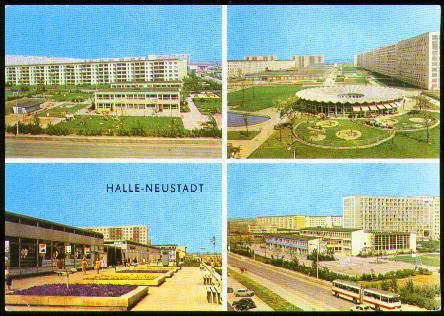
May 6, 2005
American suburbs are "a chaotic and depressing agglomeration of buildings covering enormous stretches of land." The cost of providing services to such "monotonous stretches of individual low-rise houses" is too high. As a result, "the search for a future kind of residential building leads logically to" high-density, mixed-use housing.
This sounds like typical writings of New Urbanist or smart-growth planners. In fact, these words were written nearly forty years ago by University of Moscow planners in a book titled The Ideal Communist City. The principles in their book formed a blueprint for residential construction all across Russia and eastern Europe. With a couple of minor changes, they could also be the blueprint for smart growth.
Mixed-use developments, wrote the Moscow planners, allow people easy access to "public functions and services" such as day care, restaurants, parks, and laundry facilities. This, in turn, would minimize the need for private spaces, and the authors suggest that apartments for a family of four need be no larger than about 600 square feet. Prior to the late 1960s, such apartments were built in five- to six-story brick buildings, but the authors looked forward to new, reinforced-concrete building techniques that would allow fifteen- to seventeen-story apartment buildings.
Like the New Urbanists, the soviet planners saw several advantages to such high-density housing. First, it would be more equitable, since everyone from factory managers to lowly janitors would live in the same buildings. While New Urbanists are less concerned about housing everyone in nearly identical apartments, they do promote the idea of mixed-income communities so that the wealthy can rub shoulders with lower-income people.
Second, the soviets believed apartments would promote a sense of community and collective values. Single-family homes were too "autonomous," they said, while the apartment "becomes the primary element in a collective system of housing." Similarly, many New Urbanists claim that their designs will produce a greater sense of community.
Third, high-density housing was supposed to allow easy access to public transportation. "Private individual transportation has produced such an overwhelming set of unresolved problems in cities that even planners in bourgeois societies are inclined to limit it," the Russians prophetically observed. With their high-density apartments, as many as 12,000 people could live within 400-yard walking distances of public transit stations. That's about 70,000 people per square mile, slightly greater than the density of Manhattan. "The economic advantages of (public transit) for getting commuters to and from production areas are obvious," says the book, "and it is also an answer to congestion in the central city."
Soviet-block countries were building such new cities even as the University of Moscow planners were writing their book. In 1970, East Germany developed a standard building plan known as the WBS 70 (WBS stands for Wohnungsbausystem, literally, "house building system") that was applied to nearly 650,000 apartments in East Berlin and other East German cities. "The WBS 70 was the uniform basis of the accelerated housing construction until the end of the GDR," says a paper titled Architecture as Ideology. According to page 23 of this paper, the WBS 70 offered a generous 700 square feet in its three-room apartments, not counting 75 square feet of private balcony.
To get an idea of just how small 700 square feet is, take a look at this photo from someone else's web site of the living room of a WBS 70 apartment in Halle. The WBS 70 was one of the major designs used in Halle-Neustadt, a bedroom community built between 1964 and 1990 for about 100,000 people on the outskirts of the manufacturing city of Halle. I first became aware of Halle-Neustadt at a 1998 conference on sustainable transportation at which two planners from the University of Stockholm declared it to be one of the most sustainable (i.e., least "auto-dependent") cities in the developed world.

As shown on a vintage postcard, Halle-Neustadt consists of rows of apartment buildings surrounded by pleasant-looking green spaces, with a central commercial area and road corridor featuring large, articulated buses. The new city was also connected to Halle by an extensive streetcar system and an S-Bahn (commuter-rail line), and the city met the "Ideal Communist City" density of about 70,000 people per square mile.
The Stockholm planners' paper noted that almost all the apartments had two bedrooms because government planners decreed "that the ideal family consisted of four family members and that the number of flat rooms should be one less than the number of family members." They also noted that the government discouraged car ownership by placing most of the parking on the outskirts of the city "at a relatively large distance from the residential houses."
What the Swedish researchers failed to note in their 1998 presentation, but faithfully recorded in their full paper, was that Halle-Neustadt was only "sustainable" during the socialist period. When Germany reunified, many residents moved out, and those who stayed bought cars so that auto ownership "reached nearly the level of western Germany." Naturally, this created major congestion and parking problems: "The cars are parked everywhere -- on pavements, bike-ways, yards and lawn." The Swedes feared that proposed construction of new parking garages would "undermine" the "planning concept of concentrating the parking places on the city's outskirts." (See page 263 of The Vanishing Automobile for a somewhat greater discussion of the Stockholm paper.)

On April 27, 2005, I had the opportunity to join Wendell Cox on a tour of Halle-Neustadt and other formerly East German cities. The first thing we noticed is that the "parking problem" is gone, as are most of the green spaces, which have been turned into parking lots.
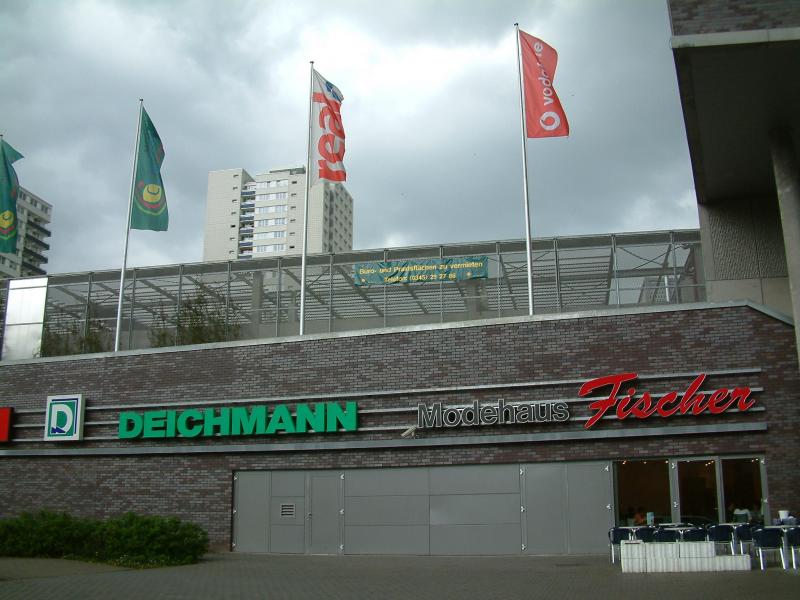
The city center also enjoys a modern new shopping mall supported by a multi-story parking garage.
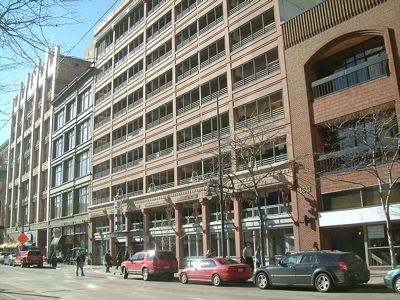
The apartment buildings themselves range from reconstructed to totally abandoned. According to various web sites on the city, Halle-Neustadt's population peaked at 94,000 in 1990 but since has fallen to 60,000. After reunification, the apartments were privatized and are now owned by various housing companies. These companies have successfully lobbied the federal government to fund the demolition of unneeded buildings, and more than two dozen high-rises in Halle-Neustadt are scheduled for destruction. Yet the population of east German cities is declining so fast that demolition cannot keep up: despite numerous demolitions, the region is expected to have even more vacant housing in 2010 than it does today.
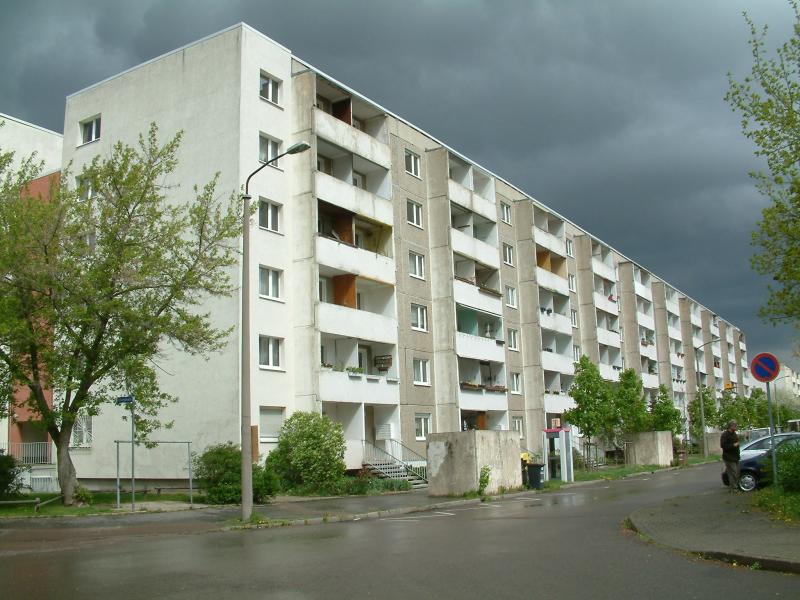
Wendell and I looked closely at two basic styles of building. First was a six-story apartment structure that probably represented the pre-mass-produced buildings described with such fanfare in The Ideal Communist City. These buildings had no elevators, so it is not surprising that many of the top floor apartments appear unoccupied.
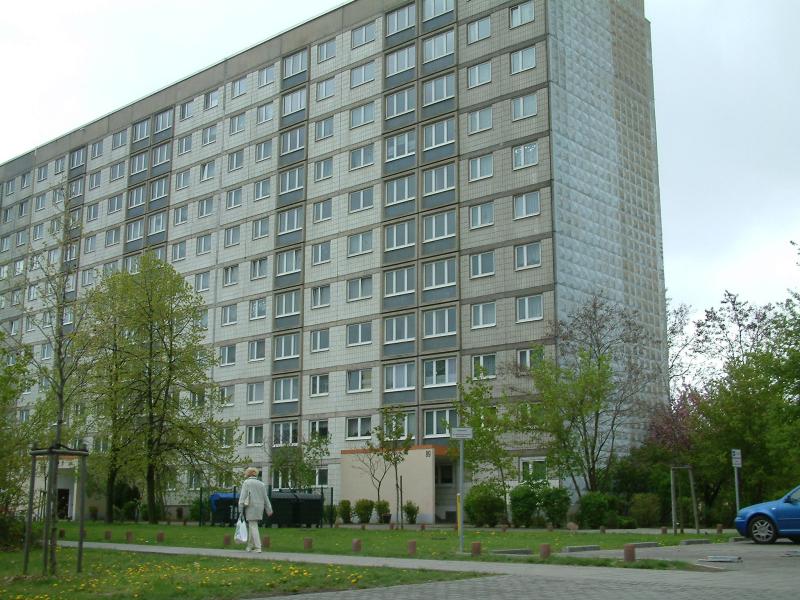
The second building type was eleven stories tall and probably represented the previously mentioned WBS 70. Some of these were in good condition, obviously reflecting investments made by the new private landlords.
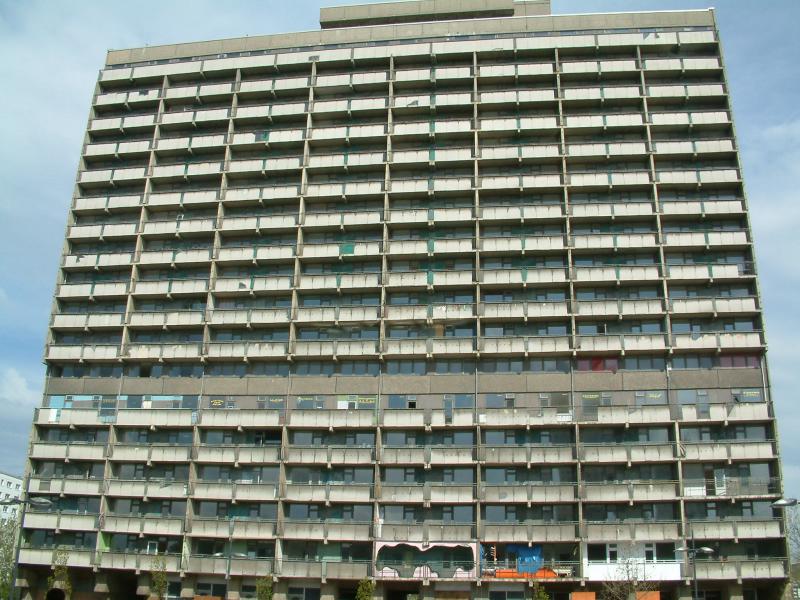
But many others were clearly abandoned and ready for demolition. We saw a few other building types, including some with even more stories, but did not examine them closely.
Germans pronounce the letter "H" as "ha" while "neu" is pronounced "noi." So residents often refer to Halle-Neustadt as "Hanoi," an ironic reference to the bombed-out nature of much of the suburb. They commonly refer to the apartments as "die platte," meaning "the slab," referring to the method of construction.
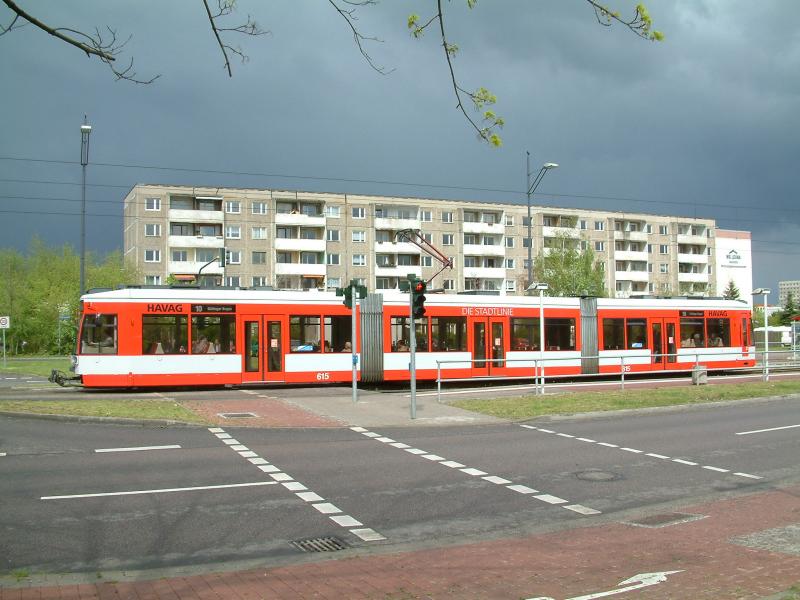
Following reunification, many of Halle's inefficient factories went out of business. The city has partly compensated by doubling the size of its university. Halle-Neustadt's central corridor still has frequent streetcar service to the university, but the commuter line connecting Hanoi with Halle's factories receives little use.
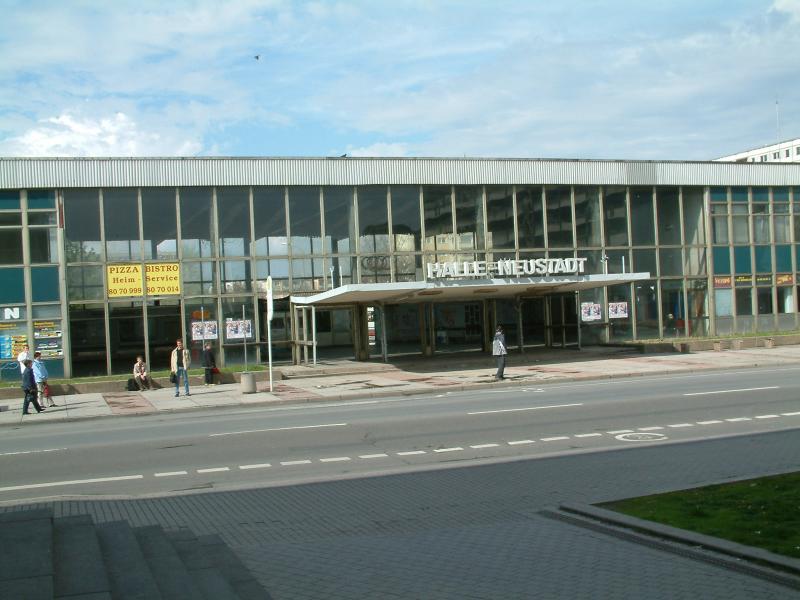
From a distance, the S-Bahn station still appears attractive.
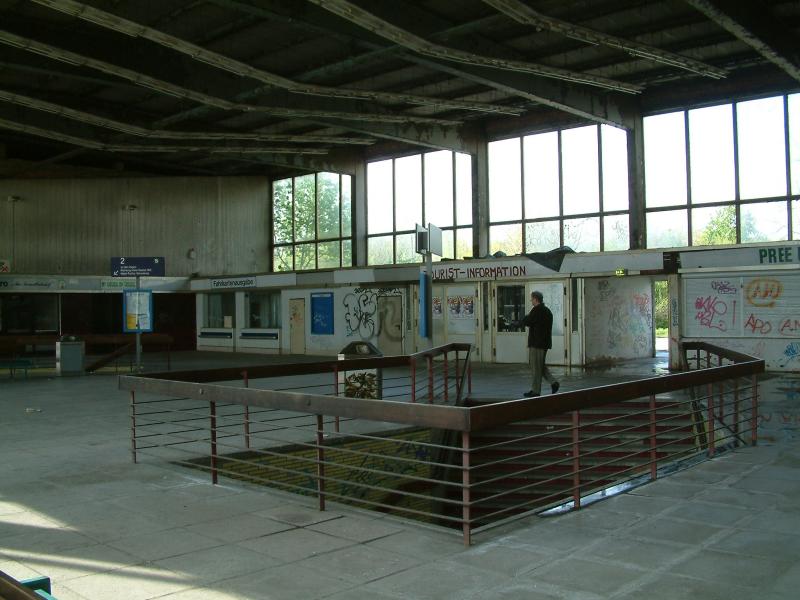
A closer look reveals many of the windows are broken, the inside is covered with graffiti, and the restaurant and other facilities advertised on the outside are abandoned. The actual loading ramp has room for fifteen-car trains, but today four-car trains are more than sufficient.

Where did all the people go? Many found jobs in western Germany; since reunification, east Germany has lost more than 1.25 million people. But many of those who stayed got away from the slabs by moving to suburbs of new duplexes and single-family homes.
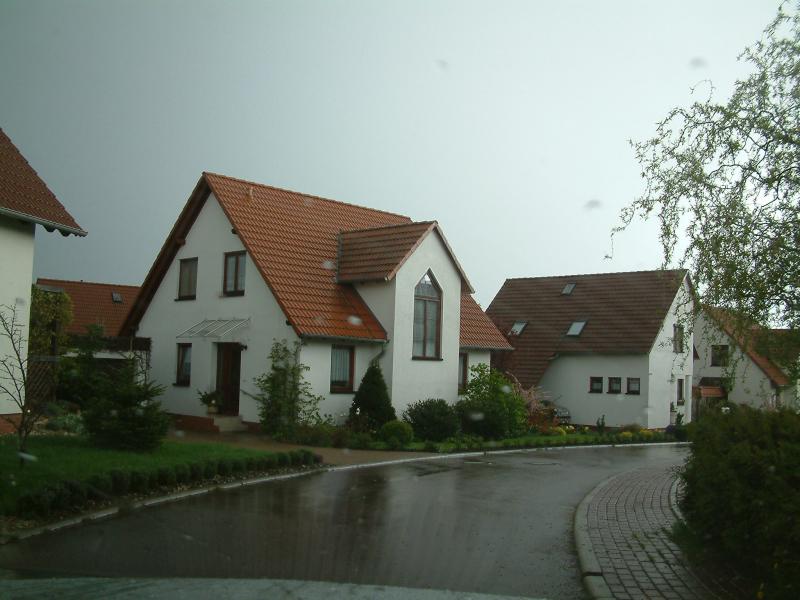
Wendell and I did not have to search very far to find such suburbs, mostly added onto existing villages.
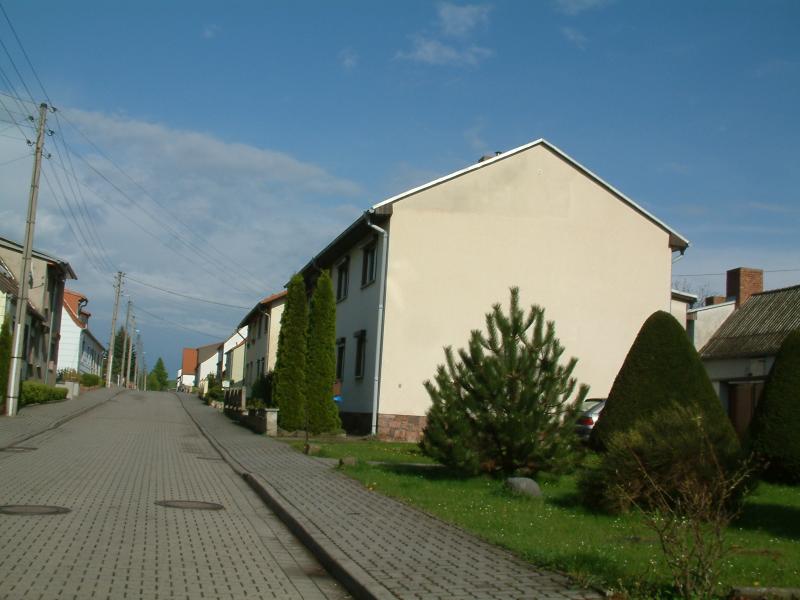
But well away from any village, in the middle of farmlands, we found several big-box stores, including a home improvement center, a furniture store, and a hypermart.
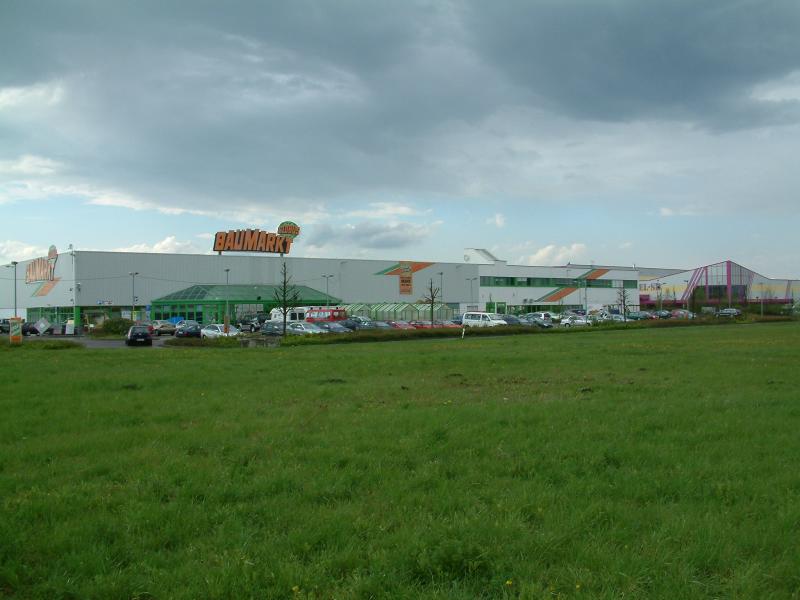
Today no one in Germany refers to such suburbs as "monotonous." This term is instead reserved for the grey slabs of concrete that most people are abandoning as fast as they can. Throughout Europe, high-rise apartments are increasingly becoming ghettos for Muslim and other foreign "guest workers." While the houses shown above are admittedly smaller than ones found in modern American suburbs, the Germans are fast catching up. A little further from Halle we found a suburban village that included many large homes with large backyards such as the one below.
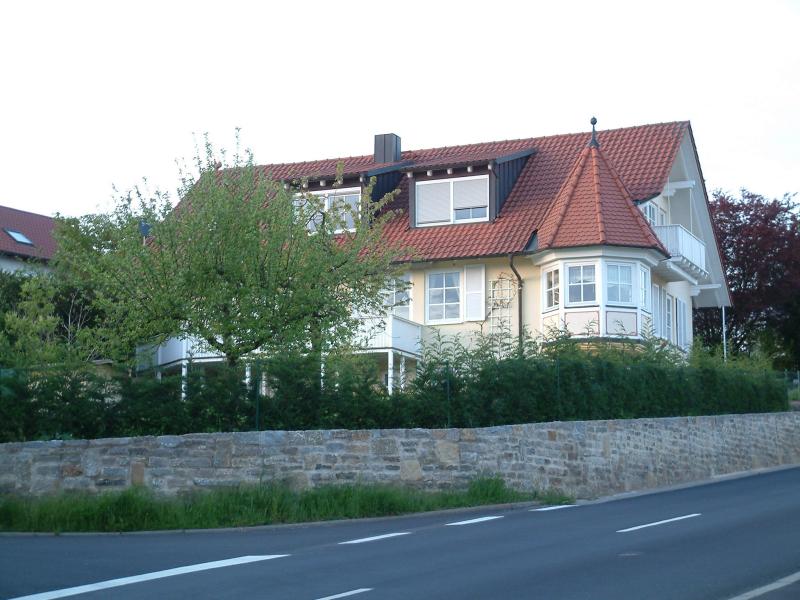
After leaving Halle-Neustadt, Wendell and I went to Berlin where we found Corbusier House, the 1957 prototype for much high-rise housing. Planning historian Sir Peter Hall calls Le Corbusier "the Rasputin of the tale" of authoritarian urban planning, because his "Radiant City" inspired so many bad urban plans around the world, including Halle-Neustadt and American public housing projects. But I suspect the 1,400 people living in Corbusier House are pleased with their setting. This is partly because, though a bad urban planner, Le Corbusier was a master architect, but mainly because Corbusier House residents chose to live there, whereas residents of soviet-block countries had no choice.
There will always be a market, though probably a small one, for high-density housing, whether in Radiant-City high rises or New-Urban mid rises. The problems arise when planners ignore the market and try to impose their ideology on people through prescriptive zoning codes, regulations, and subsidies.
I have always resisted the notion that smart growth and sustainability are some kind of international plot to take away American sovereignty. Even if it were true, saying so marks one as a kook and eliminates all credibility. But I don't think it is true; we have enough central planners in our own midst that we don't have to look for them elsewhere.
And yet I get a creepy feeling when I look at the publication date of "The Ideal Communist City." Though written in the mid 1960s, the book was first released in English by a New York socialist publisher in 1971.
The earliest mention of smart-growth concepts I can find in the planning literature came out just two years later in the book, Compact City: A Plan for a Livable Urban Environment. Like The Ideal Communist City, Compact City advocated scientific or "total-system planning." Like The Ideal Communist City, but unlike New Urbanists, Compact City advocated high-rise housing. Like the New Urbanists, it quoted Jane Jacobs' book, The Life and Death of Great American Cities, in support of mixed-use and transit-oriented developments.
By 1980, research by Northwestern University economist Edwin Mills had thoroughly discredited the hypothesis that more compact cities would have less congestion and air pollution because people would be more likely to walk and ride transit. That didn't stop the U.S. House of Representatives from holding hearings titled Compact Cities: A Neglected Way of Conserving Energy. In 1996, compact cities were tied to sustainability in a book titled, Compact City: A Sustainable Urban Form?
Which brings us full circle to 1998 when University of Stockholm researchers tell an international group of planners that Halle-Neustadt is one of the most sustainable cities on earth -- knowing full well (but not mentioning) that the prerequisite for Hanoi's sustainability was keeping its residents poor and oppressed.
While I don't seriously equate urban planners with communists, the similarities between the Ideal Communist City and smart growth are far more numerous than their differences. As the table below shows, both seek to use planning to create a sense of community and promote collective rather than individual transportation. Beyond the superficial difference that the soviets preferred high rises and smart growth prefers mid rises, the main difference is that the communists tried to put everyone in identical small apartments while smart growth allows people to have as big a house or apartment as they can afford, but just tries to get them to build those houses on small lots.
Concept Ideal Communist City Smart Growth Higher density housing Yes Yes Mixed-use developments Yes Yes Mixed-income housing Yes Yes Transit-oriented development Yes Yes Discourages auto parking Yes Yes Calls suburbs "monotonous" Yes Yes Minimizes private yards Yes Yes Maximizes common areas Yes Yes Minimizes private interiors Yes No Height of residential buildings High Rise Mid Rise
Though they publicly claim they want to reduce congestion, most smart-growth plans admit they seek to increase congestion to encourage people to use transit. Though they publicly claim to worry about affordable housing, smart-growth plans drive up land and housing costs with the hidden agenda of encouraging people to live in multifamily housing or at least on tiny lots.
Before visiting Europe, I spent a few days in Madison, Wisconsin. After returning, I spent a few days in Hamilton, Ontario. Though neither region is growing particularly fast, in both places politicians talk about the dangers of uncontrolled growth and how the firm hand of government planning was needed to prevent chaos and sprawl. Part of their plans, of course, call for packing more of that growth into urban infill than the market would build.
In particular, the plan for Hamilton requires that 40 percent of all new development be high-density infill. Currently the rate is just 18 percent. Now, 40 percent is a lot less than the near-100 percent imposed by Russia and East Germany. But Hamilton's plan means that 22 percent of its new residents will be forced to live in housing that they wouldn't normally choose. Experience in Portland and other cities shows that regulation that attempts to make much smaller changes in the housing market can lead to huge increases in housing costs.
Planners call this giving people more "choices"; what they mean is forcing people to accept lifestyles that they would not choose for themselves. How is this fundamentally any different from the philosophy of the Ideal Communist City?